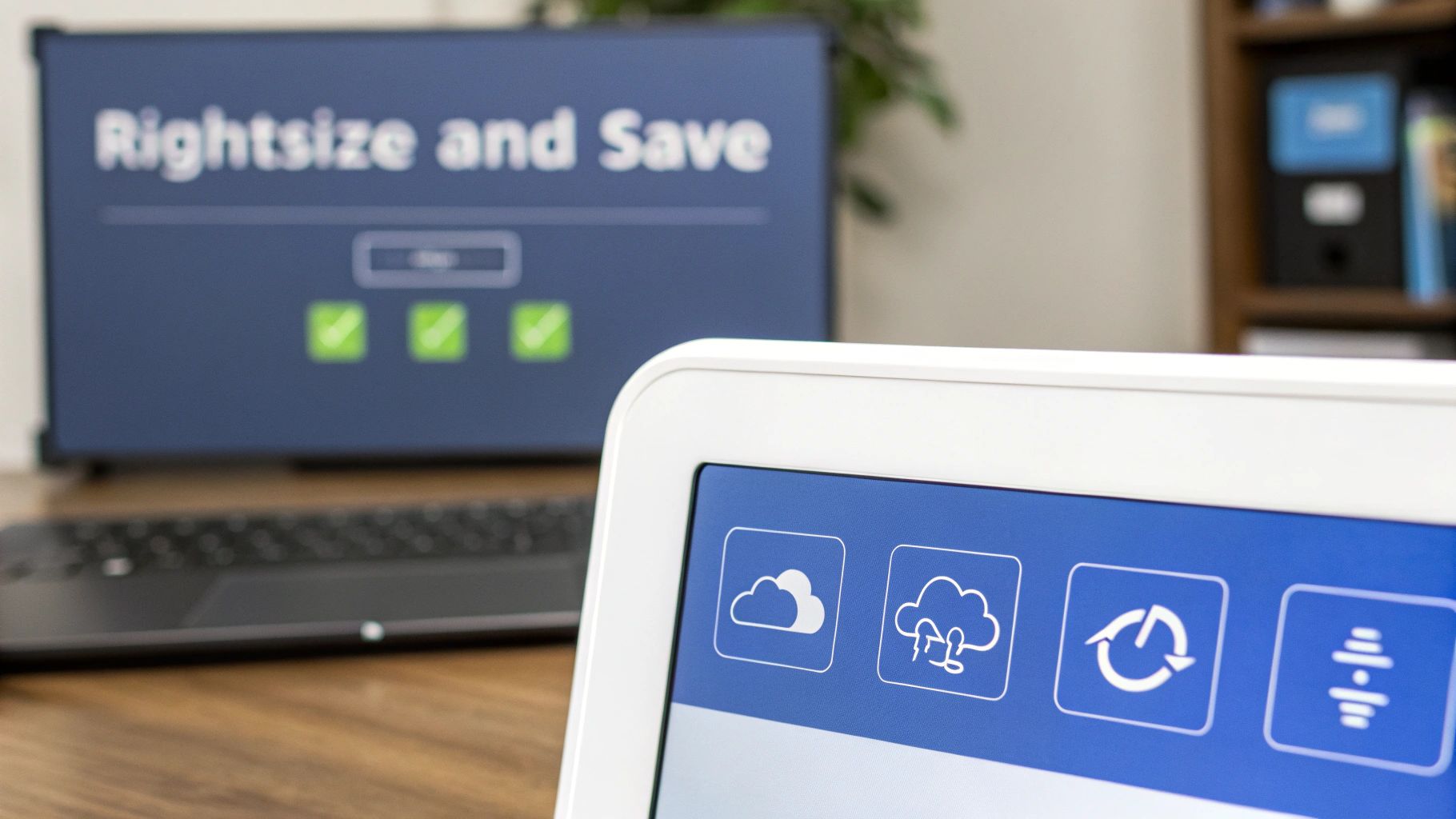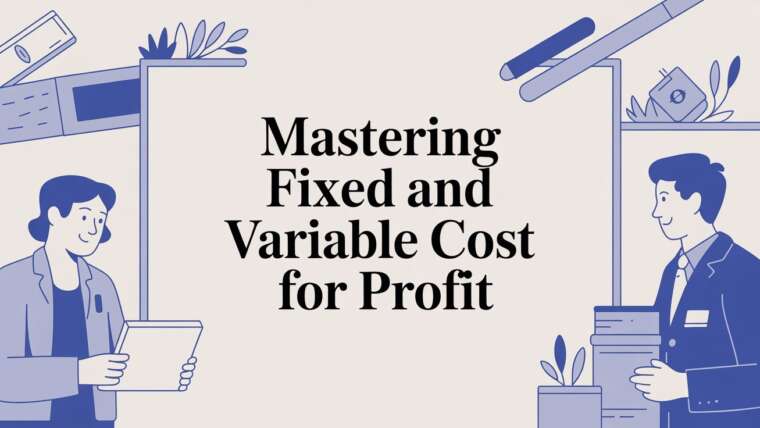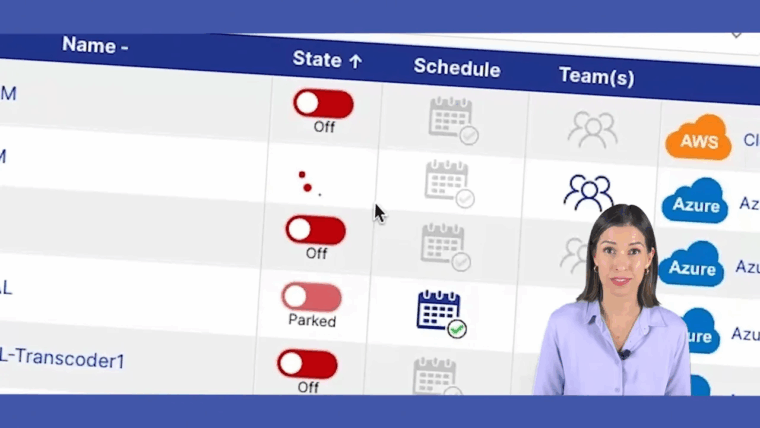So, what exactly is cloud cost optimization? Think of it as the ongoing, disciplined practice of cutting down your total cloud spending without sacrificing performance, reliability, or your ability to grow. It’s not a one-and-done project. It's about systematically hunting down waste, right-sizing your resources, and making sure every single dollar you spend in the cloud is actively working to support your business goals.
What Is Cloud Cost Optimization?
Let’s use a simple analogy: your cloud bill is a lot like your home's electricity bill. If you leave all the lights on in empty rooms, you're paying for electricity that isn't providing any value. It's just waste. In the cloud, running oversized servers, forgotten test environments, or idle databases is the exact same thing. This "cloud waste" silently drains your budget.
Cloud cost optimization is the process of finding and turning off those proverbial lights.
And this isn't a minor issue. With global public cloud spending expected to hit a staggering $723.4 billion in 2025, it’s no wonder that cost management is now a top priority for 67% of CIOs. The real shocker? Studies reveal that an estimated 32% of that cloud spend is completely wasted on things like overprovisioning and weak governance.
The Goal Beyond Just Cutting Costs
But effective optimization isn't just about slashing your bill. It’s about building a leaner, more efficient engine for your business. The real goals are much smarter:
- Eliminating Waste: This is the low-hanging fruit. It means identifying and shutting down idle or completely unused resources, like old test servers or unattached storage volumes that nobody remembers.
- Improving Efficiency: This involves matching your server sizes to what your applications actually need. This practice, often called "rightsizing," stops you from paying for horsepower you never use.
- Maximizing Value: Ultimately, it's about making sure your cloud investment directly fuels business outcomes, drives innovation, and supports growth. You can dive deeper into this by reading about the real cost of cloud services in our detailed guide.
This handy concept map breaks it down perfectly, showing how optimization is all about reducing waste and boosting efficiency to deliver real business value.
As the infographic shows, true optimization is a balanced strategy, not just a frantic cost-cutting exercise. To help clarify these core ideas, here's a quick breakdown of the key pillars you should build your strategy on.
Key Pillars of Cloud Cost Optimization
| Pillar | Description | Example Action |
|---|---|---|
| Visibility | You can't manage what you can't see. This means having clear insight into where every dollar is going across all your cloud services and accounts. | Implementing a cost visualization tool to track spending by department, project, or resource tag. |
| Accountability | Assigning ownership of cloud costs to the teams that incur them. When engineering teams see their own budget impact, they build more efficiently. | Creating showback or chargeback reports that link cloud usage directly to specific teams or products. |
| Optimization | The hands-on work of reducing costs. This includes rightsizing, shutting down idle resources, and using cost-effective pricing models. | Automating schedules to turn off development and test environments outside of business hours. |
| Governance | Establishing rules and policies to prevent cost overruns before they happen. It’s about setting guardrails for your teams. | Creating policies that restrict the creation of expensive, high-performance virtual machine types without approval. |
By focusing on these four pillars, you move from simply reacting to high bills to proactively managing your cloud spend for maximum impact.
Why Managing Cloud Costs Is So Important
Think of unmanaged cloud spending like leaving the lights on in an empty skyscraper. It's a silent, constant drain on your resources that delivers zero business value. While saving money is the obvious goal of cloud cost optimization, its real importance goes far deeper, directly impacting your company's financial health and competitive edge.

Without a clear strategy, cloud bills can quickly spiral out of control. We see it all the time: organizations find their spending grows much faster than their revenue, creating a serious financial burden. This isn't a small problem. Industry research consistently shows that up to 30-35% of all cloud spend is considered waste, usually coming from idle or over-provisioned resources.
That waste directly stifles growth. Every dollar spent on an unused server is a dollar that you can't invest in developing new products, hiring talented people, or marketing your services.
Beyond the Balance Sheet
Effective cost management isn't just about cutting expenses; it's about reallocating that capital to where it actually matters. By trimming the fat, you unlock funds for the initiatives that push your business forward.
- Fueling Innovation: Freed-up capital can be reinvested directly into research and development, letting you build better products and stay ahead of the competition.
- Improving Operational Efficiency: A focus on cost forces teams to be more deliberate about resource usage. The natural result is leaner, more efficient applications and infrastructure.
- Creating Financial Predictability: When you have a firm grip on your cloud spending, you can create far more accurate financial forecasts. This stability is crucial for long-term planning and keeping investors confident.
Ignoring these issues is a huge risk. Unexpected budget overruns can halt important projects in their tracks, creating internal friction and killing momentum.
The ultimate takeaway is clear: proactive cloud cost management is not just an IT task. It is a core business discipline that is directly tied to your company's sustainability and long-term success.
By shifting your approach from reactive to proactive, you turn your cloud investment from a potential liability into a powerful strategic asset. For any business looking to thrive, that shift is absolutely fundamental.
Proven Strategies for Reducing Your Cloud Spend
It’s one thing to realize your cloud bill is creeping up, but it's another thing entirely to know what to do about it. The good news is that you don’t need to be a financial wizard to get your spending under control. There are several battle-tested strategies you can put into practice right away to start trimming that bill.
These aren't just abstract theories; they're practical, hands-on techniques that form the core of effective cloud cost optimization. Think of them as the levers you can pull to turn wasteful spending back into capital you can use to grow your business.

These methods range from simple tweaks you can make today to bigger architectural decisions. But they all share the same goal: making sure you only pay for what you actually use.
Rightsizing Your Resources
One of the most common, and expensive, mistakes we see is a failure to rightsize resources. It's a simple concept: analyze how your virtual machines and other services are performing, then adjust their size to match what the workload truly needs.
It’s tempting for teams to overprovision resources "just in case," but that caution comes with a hefty price tag. You end up paying for powerful servers that are barely breaking a sweat. For instance, a dev team might be using a massive, costly server instance for an app that only sips CPU and memory. A quick check of its usage could reveal an opportunity to downsize to a smaller, cheaper instance, potentially cutting that resource’s cost by 50% or more with zero impact on performance.
Embracing Automation and Dynamic Scaling
Why manually manage costs when the cloud can do it for you? Modern cloud platforms are packed with powerful automation tools designed for this exact purpose. Autoscaling is a classic example. It lets your application automatically add or remove servers based on real-time traffic, so you aren’t paying for peak capacity during the quiet overnight hours.
Another quick win is simply scheduling shutdowns. Do your development and staging environments really need to run 24/7? Probably not.
By setting up a simple automation to shut down non-production resources overnight and on weekends, many companies slash those specific costs by as much as 70%. It's one of the fastest ways to see a real drop in your bill.
Committing for Discounts
If you have workloads that are predictable and always on, you can unlock huge savings with pricing models like Reserved Instances (RIs) and Savings Plans. The deal is simple: you commit to using a certain amount of compute power for a one or three-year term, and in return, the cloud provider gives you a steep discount compared to on-demand prices.
But that’s just scratching the surface. A few other powerful methods include:
- Using Spot Instances: Got workloads that can handle interruptions, like data processing or batch jobs? Spot Instances let you bid on spare cloud capacity at jaw-dropping discounts of up to 90%.
- Optimizing Storage: Don't pay premium prices for old data. Implement storage tiering to automatically move less-frequently accessed files to cheaper, long-term storage classes.
When you start combining these techniques, the impact is huge. Well-executed cloud cost optimization strategies can trim unnecessary spending by 20-30%, freeing up cash for projects that actually drive the business forward.
Choosing the Right Tools to Manage Cloud Expenses
Let's be realistic: manually tracking every dollar you spend in a complex cloud environment is a losing battle. It's nearly impossible. This is where dedicated tools come in, transforming the painful process of cloud cost optimization into something manageable by turning raw spending data into insights you can actually use.
The trick is choosing the right tool, which really depends on your specific needs, how your infrastructure is set up, and who's on your team.
The market for these solutions is booming for a good reason. As cloud setups get more complicated, companies are leaning heavily on specialized tools to get a handle on their spending. In fact, the cloud cost management tools market hit nearly $9.8 billion in 2024 and is expected to keep climbing, driven by the need to see everything clearly across multi-cloud and hybrid environments. You can read more about this market growth trend on gminsights.com.
Native Cloud Provider Tools
Your first stop is often the tools built right into your cloud platform, like AWS Cost Explorer or Azure Cost Management. They’re a great starting point for organizations that live entirely within a single cloud. You get solid visibility into where your money is going and some basic forecasting to help you plan.
Because they’re built-in, they feel familiar and give you a good baseline for analysis. Here’s a quick look at the AWS Cost Management dashboard, which does a nice job of visualizing spending trends.
As you can see, the dashboard lays out your cost and usage data, making it easier for teams to spot which services are driving up the bill. The major catch? These tools only see their own ecosystem, which leaves you with massive blind spots if you're running a multi-cloud setup.
Third-Party and Open-Source Platforms
This is exactly where third-party platforms shine. Tools like CloudZero or Flexera are built from the ground up for multi-cloud visibility. They pull all your spending data from AWS, Azure, and Google Cloud into one unified view so you can see the whole picture.
Often, these platforms offer much more advanced analytics, anomaly detection that flags surprise costs, and automated recommendations that go way beyond what the native tools can do.
For a deeper dive into your options, you might be interested in our complete guide to the best cloud cost optimization tools available today.
Ultimately, the goal is to find a tool that transforms complex billing data into a clear narrative. It should tell you not just what you spent, but why you spent it and how you can spend it smarter next time.
For teams with very specific, niche requirements, open-source tools can also fill in the gaps. They can offer custom solutions for particular optimization tasks without the price tag of a commercial platform.
Building a Sustainable Cost Optimization Culture

Let’s be honest: tools and clever strategies are great, but they’ll only take you so far. The real secret to winning at cloud cost optimization for the long haul is building a company-wide culture of cost awareness. This is about moving beyond one-off technical fixes and weaving financial accountability into the fabric of your daily operations.
This cultural shift has a name: FinOps. It’s all about getting engineering, finance, and business teams in the same room, collaborating on cloud spending decisions. When everyone shares a sense of ownership, cost management stops being "an IT problem" and becomes a shared responsibility. That collaborative mindset is what turns good intentions into sustainable savings.
Creating Accountability and Visibility
You can't manage what you can't see. The very first step is to create total clarity on where every single cloud dollar is going. This is where putting some solid, consistent processes in place makes a world of difference.
- Implement Resource Tagging: Get serious about a strict tagging policy for all cloud resources. Tagging lets you slice and dice costs by team, project, or product, making it painfully obvious who is spending what.
- Establish Budgets and Alerts: Don't wait for the bill to get a surprise. Set proactive spending budgets for different teams and configure alerts that fire off when costs get close to their limits. This stops overspending before it spirals out of control.
- Define Governance Policies: Lay down clear rules about who can spin up new resources and what types are allowed. Good governance prevents rogue deployments and stops unnecessarily expensive services from ever being launched.
True cost optimization isn't a reactive chore you do once a quarter; it's a continuous process. By making cost a key part of every decision, you turn accountability into a company-wide habit that pays dividends for years to come.
Common Questions About Cloud Cost Optimization
Getting into cloud cost optimization always kicks up a few questions. It's totally normal. Getting straight answers is the best way to move forward and dodge the common mistakes that trip people up. Let's tackle some of the big ones.
How Often Should We Optimize Cloud Costs?
It’s easy to think of optimization as a one-and-done project, but that's a trap. Your cloud environment is always changing; new resources get spun up, workloads shift, and projects come and go.
Because of this constant motion, optimization has to be a regular thing. Think of it less like a project and more like a routine, something you build into your weekly or monthly ops reviews. It’s a discipline, not a destination.
What Is the Biggest Cloud Cost Mistake?
By far, the most expensive mistake we see is the classic "lift and shift" migration. This is when a company takes its on-premise applications and just plops them into the cloud without any changes.
This approach almost always leads to massive overprovisioning from day one. You end up paying for cloud resources that mirror your old hardware's capacity, which is rarely what your application actually needs, creating instant and significant waste.
Can Optimizing Cloud Costs Hurt Performance?
That’s a fair question, but here’s the thing: true optimization should never compromise performance. The goal isn't just to slash resources across the board. It's about matching them perfectly to what your application actually needs to run well.
When you do it right, things like rightsizing and improving efficiency can actually boost performance. Why? Because you're getting rid of bottlenecks caused by clunky, poorly configured infrastructure. The trick is to base your changes on real data, not guesswork. That way, you strike the perfect balance between what you spend and what you get.
Ready to stop paying for idle cloud resources? CLOUD TOGGLE makes it easy to automate server shutdowns and slash your cloud bill. Start your free 30-day trial and see how much you can save.




